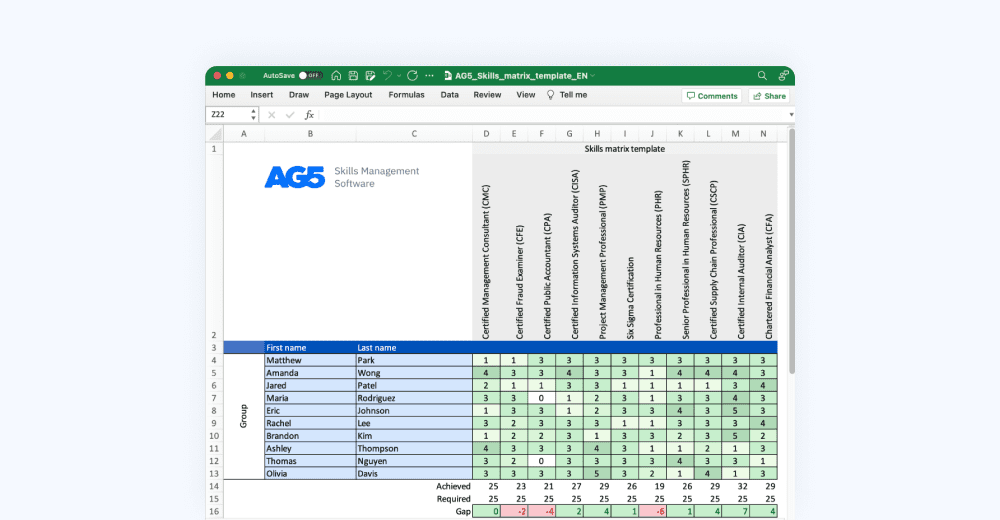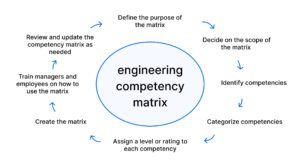Engineering competency matrix: Free templates to get started
In this article, we discuss engineering competency matrices and offer free templates to get started. It outlines the importance of competency mapping and provides practical tools for effective implementation.

Engineering is one of the most critical industries in today’s economy. It plays a vital role in developing new technologies and infrastructure, and helps keep society running smoothly. However, a new study from the Institution of Engineering and Technology (IET) has shown that less than half of new engineering recruits have the skills they need for work. This is a massive problem, as businesses are struggling to find employees with the right skills, and new engineers are entering the workforce without proper training. One way to address this issue is by creating a competency matrix for your engineering team. This blog post will discuss a competency matrix, why it’s essential, and how to build one.
What is an engineering competency matrix?Copied

An engineering competency matrix is a tool used by engineering organizations to assess the skills and knowledge of their workforces. The matrix can identify employees needing additional training as well as potential new hires, and track employee development. A matrix is also a valuable tool for succession planning, as it can help identify gaps in an organization’s engineering talent pool.
The competency matrix consists of ratings from “highly competent” to “not competent,” which are assigned to each employee based on performance on various tasks and projects. These ratings are used to create a profile of the employee’s strengths and weaknesses. This information can be used to identify areas in which employees need additional training or development.
Additionally, a competency matrix can be used to assess an employee’s potential for advancement within the organization. Ultimately, competency matrices are valuable tools for engineering organizations of all sizes. They can help ensure that employees have the skills and knowledge needed to perform their jobs effectively and contribute to the organization’s success.

Benefits of an engineering competency matrixCopied
It is more important than ever for organizations to have a clear and concise way to measure the competencies of their employees. An engineering competency matrix is a tool that can provide significant insights into the skills and abilities of an organization’s workforce. Let’s take a closer look at some of the benefits of using an engineering competency matrix.
- Employees: An engineering competency matrix can be used as an employee development tool. By understanding where they fall on the matrix, employees can identify areas they need to improve, then develop a plan to do so. Additionally, a matrix can help employees understand how their skills stack up against their peers – and what they can do to stand out from the crowd.
- Managers: Managers can use it to make staffing decisions. Because they have an oversight of the skills and abilities of their employees, managers can make more informed decisions regarding whom to assign to specific projects. Additionally, a matrix can help managers identify training and development needs within their team, so they can address them promptly.
- Organization: From an organizational standpoint, an engineering competency matrix can be used to benchmark the skills of an organization’s workforce against industry standards. Additionally, it can help organizations identify potential areas of risk, so they can take steps to mitigate them.
- Customers: Finally, from a customer perspective, the ability to quickly and effectively fill skill gaps helps organizations provide better customer service.
Can’t wait to get started? Here are five free skills matrix templates and samples for you to download.
How to create an engineering competency matrixCopied

Creating an engineering competency matrix may seem daunting at first glance, but it can be easily broken down into simple steps. Follow these steps, and you will have a matrix tailored to your organization’s needs.
Define the purpose of the matrix
Before you begin, it is vital to take some time to think about what you want the matrix to achieve. Do you want to use it to assess the skills of individual engineers? To identify training and development needs? To track progress over time? Once you have defined the purpose of the matrix, you will be able to tailor it to meet your specific needs.
Decide on the scope of the matrix
When creating an engineering competency matrix, it’s important to determine its scope. Will the matrix assess all engineers in the organization, or just those in a particular department or location? Will it focus on skills, certifications, or project management? After defining the scope, you can develop a list of competencies that you should include in the engineering competency matrix.
Identify competencies
You can do this step in several ways. You could ask managers to identify the critical competencies for their team members, survey employees to find out which competencies they feel are most important, or review job descriptions to identify required and desired skills. Once you have compiled a list of competencies, you will need to decide how they should be grouped.
Categorize competencies
One way to group competencies is by level, with Level 1 being entry-level skills and Level 5 being expert-level skills. Another way to group competencies is by function, with categories such as design, manufacturing, or quality assurance. There is no right or wrong way to group competencies; choose a method that makes sense for your organization.

Assign a level or rating to each competency
Assessing whether an engineer possesses the necessary skills for their current role and identifying areas that require additional training is the purpose of this step. One way to assign levels is using a scale of 1-5, with one being entry-level and five being expert-level. Another way is to use a rating system of novice, intermediate, advanced, or expert. Again, there is no right or wrong way to do this; choose a method that makes sense for your organization.
Create the matrix
There are a few ways you can create an engineering competency matrix. One option is to use Excel or another spreadsheet program. Another is to create a table using HTML code. You can also use skills matrix software. Whatever you choose, make sure it will be manageable for both team leaders and team members on an ongoing basis.
Train managers and employees on how to use the matrix
Once you have created a matrix, it is essential to train managers and employees on how they can benefit from it. An important step is integrating it into your performance management system, so it becomes part of your organizational culture. Doing so will help ensure that your matrix achieves its intended purpose.
Review and update the competency matrix as needed
As times change and new technologies emerge, the skills and experiences required for specific jobs and roles will also change. Keeping your competency matrix up to date is essential to accurately reflect your business’s current needs.

AG5 engineering competency matrixCopied
AG5 provides software solutions that can help companies assess their employees’ skills and identify areas in which additional training may be needed. By evaluating employees against these competencies, companies can visualize their strengths and weaknesses. If this data is used properly to create tailored training programs, employees are better able to enhance their skill sets to meet the company’s needs.
With the AG5 Engineering Competency Matrix, organizations can ensure their employees have the skills they need to succeed.
Transform the way you manage your team’s skills! Download our free skills matrix templates now.

